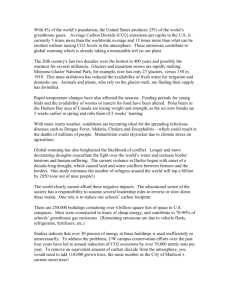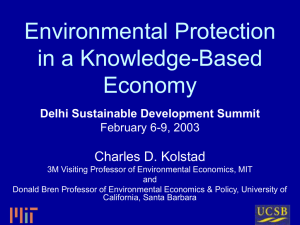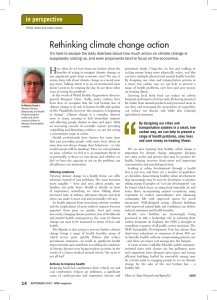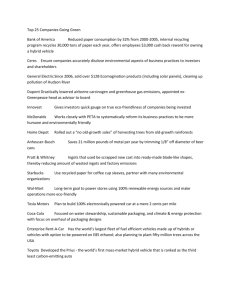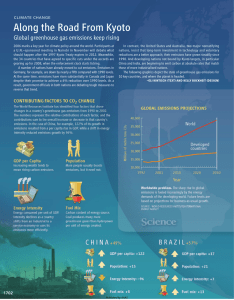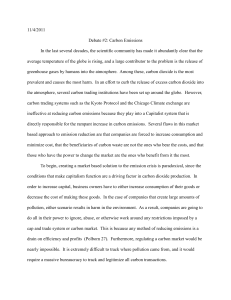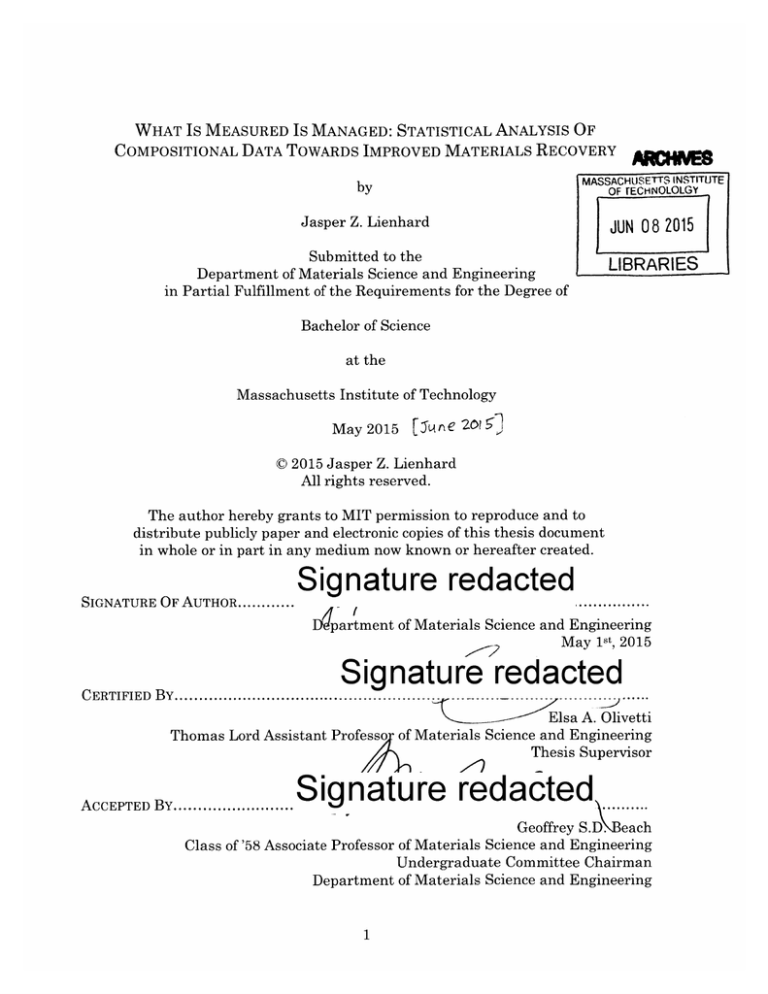
WHAT IS MEASURED IS MANAGED: STATISTICAL ANALYSIS OF
COMPOSITIONAL DATA TOWARDS IMPROVED MATERIALS RECOVERY
ARle S
by
MASSACHUSETTS INSTITUTE
OF TECHNOLOLGY
Jasper Z. Lienhard
JUN 08 2015
Submitted to the
LIBRARIES
Department of Materials Science and Engineering
in Partial Fulfillment of the Requirements for the Degree of
Bachelor of Science
at the
Massachusetts Institute of Technology
May2015
2
[~tnC
f
0 2015 Jasper Z. Lienhard
All rights reserved.
The author hereby grants to MIT permission to reproduce and to
distribute publicly paper and electronic copies of this thesis document
in whole or in part in any medium now known or hereafter created.
redacted
SIGNATURE OF AUTHOR............Signature
I 4 partment of Materials Science and Engineering
2
May 1st, 2015
Signature redacted
C ERTIFIED B y ...............................................
Elsa A. Olivetti
Thomas Lord Assistant Professo of Materials Science and Engineering
Thesis Supervisor
ACCEPTED By......................Signature
redacted
Geoffrey S.D. Beach
Class of '58 Associate Professor of Materials Science and Engineering
Undergraduate Committee Chairman
Department of Materials Science and Engineering
1
ACKNOWLEDGEMETS
I would like to provide my sincerest thanks to my thesis advisor, Professor Elsa
Olivetti for her guidance throughout the development of this work. Professor
Olivetti provided helpful feedback at every step in the research and writing of this
thesis, and I appreciate all that I have learned about industrial ecology from her. I
have very much enjoyed working with her and the rest of her research group over
the last five months.
I would also to thank the rest of the materials science and engineering faculty and
staff at MIT for providing me with so many challenges and growth opportunities
throughout the last four years. I appreciate the support and guidance from the
many instructors I have had the chance to interact with in the department.
2
WHAT IS MEASURED IS MANAGED: STATISTICAL ANALYSIS OF COMPOSITIONAL DATA
TOWARDS IMPROVED MATERIALS RECOVERY
by
Jasper Z. Lienhard
Submitted to the Department of Materials Science and Engineering
on May 1, 2015 in Partial Fulfillment of the
Requirements for the Degree of Bachelor of Science in
Materials Science and Engineering
ABSTRACT
As materials consumption increases globally, minimizing the end-of-life
impact of solid waste has become a critical challenge. Cost-effective methods of
quantifying and tracking municipal solid waste contents and disposal processes are
necessary to drive and track increases in material recovery and recycling. This work
presents an algorithm for estimating the average quantity and composition of
municipal waste produced by individual locations. Mass fraction confidence
intervals for different types of waste were calculated from data collected by sorting
and weighing waste samples from municipal sites. This algorithm recognizes the
compositional nature of mass fraction waste data. The algorithm developed in this
work also evaluated the value of additional waste samples in refining mass fraction
confidence intervals. Additionally, a greenhouse gas emissions model compared
carbon dioxide emissions for different disposal methods of waste, in particular
landfilling and recycling, based on the waste stream. This allowed for identification
of recycling opportunities based on carbon dioxide emission savings from offsetting
the need for primary materials extraction. Casework was conduced with this
methodology using site-specific waste audit data from industry. The waste streams
and carbon dioxide emissions of three categories of municipal waste producers,
retail, commercial, and industrial, were compared. Paper and plastic products,
whose mass fraction averages ranged from 40% to 52% and 26% to 29%,
respectively, dominated the waste streams of these three industries. Average carbon
dioxide emissions in each of these three industries ranged from 2.18 kg of CO 2 to 2.5
kg of CO 2 per kilogram of waste thrown away. On average, Americans throw away
about 2 kilograms per person per day of solid waste.
Thesis Supervisor: Elsa Olivetti
Title: Thomas Lord Assistant Professor of Materials Science and Engineering
3
Contents
1
Introduction
1.1
Quantifying Municipal Waste Disposal Practices
1.2
1.3
1.4
2
3
Compositional Data Analysis
Carbon Dioxide Emissions Reduction Potential
Contributions
6
8
11
12
14
Methodology
15
2.1
2.2
Calculation of Mean Mass Fractions for Ten Waste Categories
Two Different Uses of Mean Mass Fraction Calculations
17
19
2.3
Analysis of the Value of Additional Samples
19
2.4
Waste Comparisons Across Three Different Industries
21
2.5
Carbon Dioxide Emissions Calculation
21
Results
24
3.1
Comparison Between 'Micro' and 'Macro' Analysis
24
3.2
Analysis of the Value of Additional Samples
26
3.3
3.4
'Macro' Comparisons Across Different Industries
Greenhouse Gas Emissions
27
30
4
Conclusions
4.1
Future Work
32
33
5
References
35
4
List of Figures
Figure 1
Figure 2a
Figure 2b
Figure 3
Figure 4a
Figure 4b
Figure 4c
An example graphical representation of mass fraction confidence
intervals diminishing as more samples are inputted .....................
Canadian commercial properties 'micro' analysis mass fractions of
ten different waste categories ...................................................
Canadian commercial properties 'macro' analysis mass fractions of
ten different waste categories ...................................................
Value of additional samples for Canadian commercial properties
'm acro' analysis ......................................................................
Canadian commercial properties 'macro' analysis mass fractions for
ten w aste categories .................................................................
Canadian manufacturing and industry 'macro' analysis mass
fractions for ten waste categories ...............................................
Canadian retail 'macro' analysis mass fractions for ten waste
categories ...............................................................................
20
25
25
26
28
28
29
List of Tables
Table 1
Table 2
Table 3
Table 4
Table 5
Table 6
Table 7
Material-specific carbon dioxide emissions data and recycling yield
d ata ......................................................................................
Canadian commercial properties 'macro' analysis mass fractions for
ten w aste categories .................................................................
Canadian manufacturing and industry 'macro' analysis mass
fractions for ten waste categories ...............................................
Canadian retail 'macro' analysis mass fractions for ten waste
categories ...............................................................................
Commercial properties CO 2 emissions by waste category ...............
Manufacturing and industry CO 2 emissions by waste category .......
Retail CO 2 emissions by waste category ......................................
5
22
27
27
27
30
30
30
1. Introduction
Management of solid waste is a global challenge that has enormous
environmental implications. The use of different waste disposal practices including
landfilling, recycling, or incineration for a given type of waste can lead to
significantly different levels of greenhouse gas emissions that contribute to climate
change. Increasing recycling rates in particular has significant emissions-reducing
potential because in many cases, recycling certain waste instead of landfilling the
same reduces energy use (and therefore greenhouse gas emissions, depending on
the source of that energy) during materials processing and manufacturing.
Furthermore, avoided landfilling may reduce methane emissions, another
significant contributor to greenhouse gas emissions (EPA, 2002). Based on the
above, recycling provides a key driver for improving material sustainability. Despite
these benefits, current recycling rates for most materials are low compared to
landfilling rates. These low rates are due to a variety of reasons such as high costs
of collection and processing, ineffective government regulation, technological
limitation in materials separation, and lack of participation by consumers (Calcott
& Walls, 2005; Porter, 2002).
Providing waste generators with more accurate quantification of their waste
practices could drive improved customer participation in recycling programs.
However, municipal solid waste recycling rates by specific material and customer
can be expensive to obtain as technology to measure the weight on a municipal solid
6
waste or recycling truck is expensive or inaccurate. Current practice in the industry
is to provide estimates of recycling rates to customers by approximating the volume
of each material within a container and combining it with an approximate material
density by broad category of paper, plastic, etc., the latter of which is derived
largely from previous experience (Waste Management Inc., personal
communication). These estimates rarely include any measure of confidence and
therefore cannot comprehend the value of additional, more accurate sampling.
Therefore, in conjunction with addressing the technological and economic barriers
to increasing recycling rates mentioned above, robust estimation methods are
needed to quantify waste content and disposal method from individual municipal
waste producers across different industries and the resulting greenhouse gas
emission implications.
This thesis describes an approach for estimating the average quantity and
composition of municipal waste produced by individual sites such as retail
buildings, office buildings, or manufacturing sites. The approach calculates a mass
fraction confidence interval of how much waste will be produced in in ten different
waste categories from sampled waste-audit data collected by sorting and weighing
the contents of samples (individual garbage bags). Additionally, the algorithm
developed in this work provides an estimated value of additional samples for
refining its predictions. Finally, after mass fraction waste content estimates are
calculated, existing material-specific greenhouse gas emission data is used to
7
provide an estimate of potential emission reductions were an individual site to
recycle applicable materials instead of putting them in their landfill-bound garbage.
The waste estimation approach created in this work uses compositional data
analysis methods that are required due to the nature of sorted waste-mass audit
data. Waste audit data that reports waste content in a mass fraction form for
different categories of waste is 'closed' in nature, meaning that each set of data
must always add to a constant sum (in the case of fractions, the sum will be one).
Conversion of data into a log-ratio representation is required before statistical
analysis can be performed. Conventional statistical analysis would lead to invalid
results because such methods are inappropriate for sum-constrained sets of data
(Pawlowsky-Glahn & Egozcue, 2006).
1.1 Quantifying Municipal Waste Disposal Practices
Management of municipal solid waste, or non-hazardous solid waste from
residential, commercial, industrial, and institutional properties, is a high priority in
communities across the world and involves utilization of several different disposal
methods. These disposal methods include source reduction, recycling, combustion
both with and without energy recovery, and landfilling (Beccali & Cellura, 2001).
Commonly, government agencies, such as the United State Environmental
Protection Agency, collect data on both the total quantity and contents of municipal
solid waste produced in a particular country, region, or locality, along with data on
the frequency with which different methods are used for waste disposal. Agencies
8
most commonly track this information in one of two ways, using either a materials
flow methodology or by conducting site-specific studies (EPA, 2012).
At a national level, a materials flow methodology is commonly used to
quantify municipal waste stream production amounts and disposal practices. This
methodology involves using a mass balance that takes into account production data,
imports, exports, and average lifespans for different products and materials. This
data is collected from industry, surveys on waste characterization, and government
commerce and population census data. The materials flow methodology produces
estimates of the amount of municipal solid waste generated on a national level,
along with the fractions of that waste that are recycled, landfilled, or combusted.
These national-level estimates can then be used to calculate local waste generation
data by scaling the waste quantity estimates to the population of a certain city or
region (EPA, 2012).
The materials flow methodology has some important weaknesses that can
diminish its accuracy and usefulness, particularly on a local level. The materials
flow methodology fails to take into account residues present on various products,
such as food left in containers. Variation in local waste generation and disposal
practices is also not accounted for when the methodology is used for local estimation
purposes. Additionally, the materials flow methodology is not useful for tracking
waste by its municipal sources. There are many types of waste, such as paper or
cardboard, which may be produced by many different types of municipal waste
producers such as factories, residences, and office buildings. The materials flow
9
methodology does not allow for quantification of waste production across different
industries or other categorizations of municipal waste producers (EPA, 2012).
At the local level, site-specific studies are sometimes used to track municipal
waste generation quantities and disposal practices. This method may be used in
conjunction with material flow approaches to complement broad assessments with
more empirical sampling. Site-specific studies involve sorting and weighing all
individual components of a waste stream then aggregating this to calculate figures
such as total recycling rates. Sampling studies have the disadvantage of being
expensive and requiring significant amounts of data collected over time to produce
accurate results (EPA, 2012).
The analysis method developed in this work uses a site-specific studies
approach to understand waste composition at individual waste producer sites. It can
also be used to integrate site-specific data into broader assessments of waste
composition trends across similar groups of waste producers, such as various
industries. The use of site-specific data in broader assessments of waste through
statistical analysis allows for consideration of local variation and allows for tracking
of waste by its municipal source. This thesis analyzed site-specific data using a
more robust data analysis approach than previous work, enabling more value to be
extracted from this resource intensive data collection strategy.
10
1.2 Compositional Data Analysis
Waste composition data from site-specific studies is collected by sorting waste
into categories and then measuring the weight of each waste category. When the
weight of each category is normalized by the total weight of all categories of sorted
waste, mass fractions for different types of waste present are obtained. Data sets
will then consist of mass fractions for different categories of waste in a sample. It is
critical to have the data in terms of fractions to estimate overall system
performance.
This type of mass fraction data is 'closed' in nature, meaning that each data set
is constrained by a constant sum, which in the case of mass fractions is one. All
components in the data set represent some part of a whole, and must always be
positive. If any one component changes, some other component must also change in
order to maintain a constant sum. As a result, traditional statistical analysis, which
is intended to be applied to unconstrained data that is free to range from minus
infinity to infinity, could lead to incorrect conclusions and should not be used
(Aitchison, 2003). Instead, an approach is used that requires the conversion of this
compositional data into log-ratios, such that the compositions will be represented as
a real vector. After this transformation, any multivariate statistical technique can
be performed on the data (Egozcue et al., 2003).
Compositional data and its required log-ratio conversions for analysis are seen
in a variety of disciplines. Geochemical data that describes the mineral components
11
of a rock in percentages or the sedimentary proportions of soil are two common
examples (Reyment, 1989).
The algorithm developed in this work for estimating the average quantity and
composition of municipal waste recognizes the compositional nature of sampled
waste audit data and proceeds accordingly by performing the necessary log-ratio
transformations before performing any statistical analysis on the data. Analysis of
waste data using compositional analysis methods have been limited in the past,
despite the fact that failure to treat closed mass fraction data sets properly can lead
to inappropriate statistical conclusions.
1.3 Carbon Dioxide Emissions Reduction Potential
In addition to modeling waste quantity and contents from individual
municipal waste producers, this research provides an estimate of carbon dioxide
emissions from recyclable materials in the waste stream that the municipal sites
failed to sort out and recycle. In many cases, these poorly managed recyclables
make up a majority of an individual municipal site's waste content.
Numerous studies, all with varying system boundaries, have been conducted
on the relative environmental merits of the most common waste disposal practices
(Denison, 1996). These studies usually involve conducting life cycle analysis on a
product including its disposition. This involves tracking all energy and greenhouse
gas inputs and outputs over the product's entire lifecycle, from raw material
extraction to waste management. Every step in the lifecycle can produce greenhouse
12
gas emissions, but the largest energy inputs and emissions outputs usually occur
during raw material acquisition, manufacturing, and waste management
(Bjdrklund & Finnveden, 2005).
Comparing greenhouse gas emissions from a waste generation standpoint,
which only considers greenhouse gas emissions from the point of product disposal by
the consumer onwards, reveals that there can be significant emissions differences
between landfilling, combustion, and recycling. Greenhouse gas emissions are
produced in a number of different ways by these three disposal practices, including
methane emissions from organic material decay in landfills and emissions from
reprocessing materials during the recycling process (Barlaz et al., 2003).
Comparisons across certain materials, such as emissions differences between
landfilling and recycling aluminum, produce particularly large discrepancies (EPA,
2002).
For the purposes of this work, a simple carbon dioxide emissions comparison
model was created to generate a rough comparison between landfilling and
recycling several common materials in municipal waste streams. Incineration of
waste was not included in this model, as it is less prevalent than landfilling in
many areas, including most of the United States. The goal of this model is to
produce awareness of the potential emissions reduction by individual municipal
sites if they were to sort out and dispose of recyclables in a separate municipal
recycling stream.
13
1.4 Contributions
This thesis provided analytical validation and casework for the methodology
for compositional data analysis developed previously by the research group in which
the author works, primarily by a former postdoctoral associate, Arash
Noshadravan. Specific contributions to this work by the author include the
development of the carbon emissions model and all casework and resulting data
analysis. This casework was intended to demonstrate the compositional data
analysis methods applied to different waste audit data collected from industry. By
using large amounts of industry data, the algorithm was used to compare waste
content and greenhouse-gas savings potential from different types of municipal
waste producers. Specifically, this work quantified waste-content differences
between retail, manufacturing, and commercial sites. This work additionally
demonstrated the accuracy of the value-of-additional-samples algorithm, so that
future users of this algorithm can make informed decisions on how many wastesamples they need to collect for accurate statistical analysis.
14
2. Methodology
Previously, data collection on lost recycling potential from municipal waste
producers has been limited. This work enables significantly more value to be
obtained from site-specific waste data, including the identification of recycling
opportunities in landfill-bound waste. An algorithm was developed that used a sitespecific sampling approach to estimate the average quantity and composition of
unsorted-recyclable municipal waste from individual municipal sites. More
specifically, this algorithm takes as input sample waste audit data collected from
municipal waste producers such as office buildings, factories, or retail stores. The
input data consists of garbage-bag samples sorted according to ten different waste
categories: paper, non-aluminum metals, aluminum, plastics, textiles, wood, glass,
organics, electronic-waste, and 'other' waste that does not fit into any of the first
nine categories. The weight of the waste belonging to each of these categories in a
garbage-bag sample, along with the total weight of the garbage-bag sample, is the
raw data used by the algorithm. Statistical analysis is then performed on this data
to provide a site-specific average and confidence interval of the mass fraction of each
of the ten waste categories. By multiplying these mass fractions by an estimate of
the total waste produced at a site over a given time period, the algorithm then
predicts the amounts of different types of waste the site will have in its (nonrecycling) waste stream over the given time period. For example, this algorithm
might estimate that over the course of a year, a certain office building will throw
15
away some total weight of cardboard in its landfilled waste stream rather than
diverting it to a recycling stream.
The algorithm developed in this work also extrapolates how the calculated
confidence intervals will narrow as the number of samples collected and inputted
increases. This allows users to clearly see the benefit of additional samples (audit
data). Users can then make informed decisions on the number of samples needed,
which could potentially save time and money that would be spent collecting more
data.
Beyond using this site-specific sampling algorithm to look at statistics on
individual municipal waste producers, the algorithm can be used on a 'macro' level
to compare waste composition across different categories of municipal sites. On the
'macro' level, instead of using the sorted and weighed contents of individual garbage
bags as inputs, the total sum of all sorted and weighed samples collected from a
single location is used as one sample representing that individual location. In other
words, for the 'macro' perspective, each input represents garbage samples from
different municipal waste producers.
Finally, average waste content numbers can then be used to estimate
potential carbon dioxide emissions savings if the municipal site were to properly
sort out applicable recyclables from their waste-stream.
To demonstrate the waste composition analysis algorithm developed in this
work, several hundred waste audit data sets, collected by Waste Management, Inc.
from their Canadian customers, were analyzed using this method. The site-specific
16
sampling algorithm was used to examine individual properties, and also was used
on a 'macro' level to compare the waste-streams and carbon dioxide emissions of
three categories of municipal waste producers: retail sites, commercial properties,
and industrial and manufacturing sites.
2.1 Calculation of Mean Mass Fractions for Ten Waste
Categories
The algorithm takes as input the weight of different categories of waste in
individual garbage bag samples collected at a particular municipal waste
production site. All waste from each sample is categorized into one of ten
categories: paper, non-aluminum metals, aluminum, plastics, textiles, wood, glass,
organics, electronic-waste, and other waste. The total weight of the garbage bag
sample is also inputted. The algorithm then normalizes the weight of each waste
category into mass fractions by dividing the category's weight by the total weight of
the garbage bag.
At this point, the compositional nature of the data requires a log-ratio
conversion to be performed before any statistical analysis can be carried out. There
are several different log-ratio conversions that could be used, including the additive
log-ratio transform, centered log-ratio transform, and isometric log-ratio
transform. In this work we chose to use the isometric-log ratio conversion, as it
allows for straightaway use of classical multivariate statistical techniques
(Pawlowsky-Glahn & Egozcue, 2006).
The procedure is as follows. For some composition of D components,
17
SD
=
{
x
=
[x. x 2 , ... ,
xn]; x, >
0, i
=
1,2,...D}
the isometric-log ratio transformation is calculated by:
ilr,.(x) = ln(x) -V,
(1)
where V is a matrix of D rows and (D - 1) columns such that V - V = I., an identity
matrix of D - 1 elements. A detailed description of this process can be found in
Egozcue et al. (2003).
After the isometric-log-ratio conversion, the composition is represented as a
real vector and any multivariate statistical technique can be used immediately. In
this case, a bootstrap-resampling process is used to calculate a confidence interval
on the mean of the mass fractions for each of the ten waste categories. Bootstrap
resampling is used because it allows for a measure of error on the mean from a
sample distribution with no knowledge of the parent distribution from which the
samples are drawn. In this algorithm, sampling with replacement is performed five
hundred times for each waste category. These five hundred bootstrap vectors are
then averaged. The isometric-log ratio transformation inverse is then performed on
each average to convert back to the original D-dimensional sample space.
At this point the ninety-five percent confidence interval on the mean is
calculated to produce a lower bound and upper bound for the mass fractions of each
of the ten waste categories.
18
2.2 Two Different Uses of Mean Mass Fraction Calculations
Using the algorithm on a 'micro' level, where each input sample represents
one garbage bag collected from one particular site, ninety-six waste audit data sets
from commercial properties across Canada were analyzed. For locations where more
than twenty-five samples were collected, the twenty-five largest samples by mass
were used as inputs.
The algorithm was also used on the previously described 'macro' scale, where
each sample input represents the waste weight sums from one individual site, for
the same Canadian commercial property data. In this case, the twenty-five largest
(by number of garbage bag samples collected) of the ninety-six commercial
properties data sets collected were inputted into the algorithm.
For comparison, the mass fraction average and confidence interval outputs
for each of the ninety-six data sets from the 'micro' analysis were then averaged and
plotted, and then compared graphically with the 'macro' commercial property
analysis.
2.3 Analysis of the Value of Additional Samples
As previously described, the algorithm developed in this work provides a
predicted value of additional samples. Additionally, the algorithm extrapolates how
the calculated confidence intervals narrow as the number of samples inputted
increases. Upper bound predictions are calculated by multiplying the distance
between the average and the upper bound values (for the current number of
19
samples) by the square root of the predicted number of samples over the square root
of the current number of samples. The same procedure is used for the lower bound
predictions. An example graphical depiction of the predicted value of additional
samples produced by the algorithm is shown in Figure 1.
1.00
0.90
Q
.
0.80
0.70
0.60
o- R - Lower
- Upper
"R
-
-
S0.50
rA 0.40
C - Lower
-C
Cd 0.30
- Upper
-o
- Lower
-0
- Upper
0.20
0.10
0.00
0
5
10
20
15
25
30
Number of samples
Figure 1: An example graphical representation of mass fraction confidence intervals
diminishing as more samples are inputted. R refers to recyclables (the sum of the
paper, metals, plastics, textiles, wood, glass, aluminum, and electronic waste
categories), C refers to compostable materials (the organic waste category), and 0
refers to other waste.
To demonstrate this additional sample value feature of the algorithm, data
from five garbage-bag samples from one randomly selected commercial property
were used as inputs. The algorithm then created a prediction of how the mass
fraction confidence intervals for recyclables (the sum of papers, non-aluminum
metals, metals, plastics, textiles, wood, glass, and electronic waste), organics, and
'other' waste would narrow as twenty additional samples are added. These
predicted values of additional samples were compared graphically and numerically
20
to the actual confidence intervals calculated when ten, fifteen, twenty, and twentyfive samples were inputted from the same commercial property data set.
2.4 Waste Comparisons Across Three Different Industries
To demonstrate the 'macro' scale use of the algorithm, and to get a sense of
the variation in waste-stream composition across different types of municipal waste
producers, 'macro' level analysis was performed on data from three different
municipal waste producer categories: retail sites, commercial properties, and
industrial and manufacturing sites. For each of these three categories, data from
twenty-five different locations was used, and the mass fraction averages and
confidence intervals over the ten previously described waste categories were
compared. A graphical depiction was then created to compare the mass fraction
averages for each of the tool's ten different waste categories across these three
industries.
2.5 Carbon Dioxide Emissions Calculation
A simple carbon dioxide emissions model was created to generate a rough
comparison between landfilling and recycling certain materials in the municipal
waste stream. The model considers five common recyclables: papers, aluminum,
plastics, non-aluminum metals, and glass. These categories represent five of the
most common recyclable materials present in municipal waste (EPA, 2002). In this
model, the average waste mass fractions calculated by the spreadsheet tool for each
21
of these five categories is multiplied by the difference in carbon dioxide emissions
between landfilling and recycling the particular material.
The difference in carbon dioxide emissions for each of the five materials is
calculated using the following equation:
(2)
a - b + (c*y)
where a represents carbon dioxide emissions from landfilling a certain amount of
material, b represents carbon dioxide emissions from processing said amount of
material into a product, c represents the carbon dioxide emissions from extracting
virgin material, and y represents the yield of the recycling process in obtaining
usable material that can be reprocessed into a new product. The model assumes
that all waste in the waste stream will be landfilled under average North American
conditions. The model only considers carbon dioxide emissions from a wastegeneration standpoint, ignoring any emissions created before the point of product
disposal. Furthermore, the model ignores any emissions due to the transportation of
waste.
Table 1: Material-specific carbon dioxide emissions data and recycling ield data.
C : C02 emIissionIs
B : C'02 emissions from
processing mnaterial
Units
Value
:
C'02 eMissions from
landfilling material
Yield
Units
Value
kgCO2/kg
0.7
kgCO2/kg
kgCO2/kg
0.95
kgCO2/kg
0.1
kgCO2/kg
0.85
0.02
kgCO2/kg
0.95
0.01
kgCO2/kg
1
kgCO2/kg
1.38
12.2
1.7
kgCO2/kg
2.5
0.42
kgCO2/kg
0.8
kgCO2/kg
1
kgCO2/kg
22
A4
0.9
0.02
kgjCO/k
kgCO2/kg
-2.72
Plastic
fromn extracting!
virgin material
Units
Value
0.9 1
Table 1 shows the values of a, b, c, and y used in Equation 1. These values
were collected from Frischknect & Rebitzer, 2005; EPA, 2002; and industry
contacts.
By summing the carbon dioxide emissions (in kilograms of COJ kilogram of
waste) over the five recyclable categories, an estimate of average emissions lost due
to failure to recycle these materials is produced. These emissions numbers were
then compared between the retail, commercial properties, and manufacturing
industries.
23
3. Results
The casework conducted as part of this thesis aimed to verify the previously
described compositional data analysis by applying it to waste audit data collected
from industry. In particular, the accuracy of the value-of-additional-samples
algorithm was demonstrated. Additionally, the waste content and greenhouse-gas
savings potential differences between retail, manufacturing, and commercial sites
were analyzed.
3.1 Comparison Between 'Micro' and 'Macro' Analysis
Results from the Canadian commercial properties 'micro' analysis revealed
paper waste accounted for about 63% of the total waste stream as shown in Figure
2a. Plastics and organics made up about 25% and 9%, respectively.
The results of the commercial properties 'macro' analysis revealed similar
information, with the waste stream dominated by paper, plastics, and organics as
shown in Figure 2b. For the 'macro' analysis, an average 83% by mass of the waste
stream could have been recycled instead of landfilled.
24
-9
-99WANNFIRMA
1.00
0.90
0.80
o
x Upper Bound
0.70
* Average
) 0.60
X Lower Bound
0.50
0.40
0.30
0.20
0.10
I
0.00
Paper
Metals (No
Aluminum)
Plastics
Textiles
Wood
Glass
Aluminum Organics
Electronic
Waste
Other
Figure 2a: Canadian commercial properties 'micro' analysis mass fractions of ten
different waste categories.
1.00
0.90
0.80
r Upper Bound
0.70
X Average
0.60
0.50
Cd
X Lower Bound
x
0.40
0.30
0.20
0.10
0.00
Paper
Metals (No Plastics
Aluminum)
Textiles
Wood
Glass
Aluminum
Organics
Electronic
Waste
Other
Figure 2b: Canadian commercial properties 'macro' analysis mass fractions of ten
different waste categories.
Although the two different analysis procedures produced similar trends in
terms of waste categorization, the specific mass fraction values across each waste
25
category varied slightly in range and value. In particular, confidence intervals on
the 'macro' analysis were significantly smaller than those calculated on the 'micro'
analysis. Some of these differences may be due to the selection of the twenty-five
samples used in the 'macro' analysis.
3.2 Analysis of the Value of Additional Samples
1.00
0.900.80
0
R - Lower
0.70
- Upper
S0.60R
0.50
-
0.40
---
-c-
Lower
-
C - Upper
0 -Lower
0.30
010.
-0
- Upper
0.00
0
5
10
20
15
25
30
Number of samples
Figure 3: Value of additional samples for Canadian commercial properties 'macro'
analysis.
The additional sample value estimates are shown in Figure 3. The curved
blue, green, and orange lines show the predicted upper and lower bounds for
recyclables, compostable, and landfilled material, respectively. The red marks show
the actual calculated confidence interval values when ten, fifteen, twenty, and
twenty-five samples are used. Clearly, the predicted values of additional samples
are very close to the actual confidence interval values when additional samples are
used. The accuracy of the prediction demonstrates this algorithm's usefulness in
26
..-
.
No ..
::
-
- -
-
determining the benefit of measuring additional samples from a municipal waste
producer, as these costly measurements may be unnecessary.
3.3 'Macro' Comparisons Across Different Industries
Table 2: Canadian commercial properties 'macro' analysis mass fractions for ten
waste categories.
Mass
.-4
fraction
results
Average
0.51
0.00
0.29
0.00
0.00
0.00
0.03
0.16
0.00
0.01
Lower Bound
0.41
0.00
0.22
0.00
0.00
0.00
0.02
0.10
0.00
0.00
Upper Bound
0.60
0.00
0.37
0.01
0.00
0.00
0.04
0.23
0.00
0.02
Table 3: Canadian manufacturing and industry 'macro' analysis mass fractions for
ten waste ca
Mass
fraction
.0
results
Average
0.40
0.03
0.26
0.05
0.01
Lower Bound
0.27
0.01
0.19
0.03
0.01
[Upper Bound_
0.51
0.04
0.35
0.03
0.08
_
0.02
0.08
0.00
0.01
0.05
0.00
0.08
0.14
0.00
0.23
0.01
Averag e
0.03
for ten waste cate oies.
Table 4: Canadian ret il'macro'
Mass
fracti )n
result s
0.14
0.00
0.00
.P"
0.52
0.01
0.26
0.01
0.01
0.00
0.02
0.13
0.00
_C
.04
_
.02
Lower Bound
0.38
0.01
0.18
0.00
0.00
0.00
0.01
0.06
0.00
Upper Bound
0.63
0.02
0.36
0.02
0.01
0.01
0.03
0.23
0.00
27
C .08
aaffiMPMH
1.00
0.90
0.80
Upper Bound
0.70
Z
%Average
0.60
X Lower Bound
Cd
k0.50
0.40
x
0.30
0.20
0.10
W- Sy WWR W
0.00
Paper
Metals (No
Aluminum)
Plastics
Textiles
Wood
Glass
Aluminum
Organics
Electronic
Waste
Other
Figure 4a: Canadian commercial properties 'macro' analysis mass fractions for ten
waste categories.
1.001
0.90
0.80
* Upper Bound
0.70
x Average
0.60
X Lower Bound
k0.50
VD
0.40
0.30
Y
x
0.20
0.10
0.00
Paper
Metals (No
Aluminum)
Plastics
Textiles
Wood
Glass
Aluminum Organics
Electronic
Waste
Other
Figure 4b: Canadian manufacturing and industry 'macro' analysis mass fractions
for ten waste categories.
28
0.90
0.80
g
-
1.00
08
Upper Bound
0.70 4
0 Average
E0.60
X Lower Bound
0.50
0.40
X
0.30
0.20
X
0.10
----------
0.00
Paper
Metals (No
Aluminum)
Plastics
Textiles
Wood
Glass
Aluminum
Organics
Electronic
Waste
Other
Figure 4c: Canadian retail 'macro' analysis mass fractions for ten waste categories.
Figures 4a, 4b, and 4c depict the mass fraction averages of the commercial
properties, manufacturing and industry sites, and retail sites. For all three
industries, paper and plastic waste (both of which are recyclable) dominated the
waste stream. The commercial properties mass fraction intervals were extremely
similar to those of retail. Manufacturing had larger average amounts of 'other'
waste than commercial properties or retail, mostly due to floor sweepings and dust,
ceramics, and other construction and manufacturing debris. Confidence interval
sizes for individual waste categories were also similar across the three different
types of municipal waste producers.
29
.............
.- M.-
3.4 Greenhouse Gas Emissions
Table 5: Commercial properties CO 2 emissions by recyclable category.
Plastics MITotal
_____
C0 2 Emissions: Average
2.16
0.03
0.15
0.00
0.00
2.35
kgCO2/kg
CO 2 Emissions: Lower Bound
1.73
0.02
0.11
0.00
0.00
1.86
kgCO,/kg
CO 2 Emissions: Upper Bound
2.61
0.05
0.20
0.01
0.00
2.86
kgCO2/k
Table 6: Manufacturing and industry C02 emissions by rec clable category.
Total
Plastics
C0 2 Emissions: Average
1.73
0.26
0.14
0.06
0.00
Emissions: Lower Bound
1.26
0.15
0.10
0.03
0.00
2.18
1.54
kgCO2 /kg
kgCOS/kg
CO 2 Emissions: Upper Bound
2.27
0.44
0.19
0.10
0.00
3.00
kgCO2/kg
C0
2
Table 7: Retail properties C02 emissions by recyclable category.
~
~Plastics
CO 2 Emissions: Average
2.23
0.12
0.14
CO 2 Emissions: Lower Bound
1.70
0.06
0.10
CO 2 Emissions: Upper Bound
2.72
0.20
0.19
Total
0.00
2.50
kgCO2/kg
0.00
0.00
1.87
0.02
0.00
3.14
kgCOP/kg
kgCO 2/kg
0.01
I
The carbon dioxide emissions estimates for failure to recycle five key
recyclables were similar between commercial properties, manufacturing, and retail.
This is expected, as the three industries had similar predicted mass fractions of
paper and plastic waste. Retail had slightly higher emissions estimation than
commercial properties or manufacturing, with 2.5 kilograms of carbon dioxide
emissions for every kilogram of waste thrown away.
The model predicts carbon dioxide emissions of 2.35 kilograms for every
kilogram of waste from a commercial property. For a sense of comparison, if a
average office building in Canada were to throw away 500,000 kilograms of waste in
a year, the emissions due to failure to recycle papers, aluminum, plastics, steel, and
30
glass.would be equivalent to 1,100 barrels of oil consumed in one year or about 45
homes' energy use for one year.
31
4. Conclusions
Managing increasing amounts of solid municipal waste is an important
challenge of the 21st century. As different waste disposal practices can lead to vastly
different levels of greenhouse gas emissions (in addition to differential
environmental impacts in categories such as ecotoxicity or land use), municipal
waste management presents an opportunity for reducing such emissions. In order to
increase recycling, which generally leads to lower levels of greenhouse gas
emissions than its alternatives, robust, but cost-effective, estimation methods are
needed to quantify waste content and disposal methods, both to understand where
opportunities for increasing recycle rates exist and to evaluate progress in
increasing recycling rates over time.
The methodology developed in this work estimates average quantity and
composition of waste produced at individual municipal sites. A mass fraction
confidence interval for different waste categories, including seven different types of
recyclables, is produced using sampled waste-audit data. This method can be used
to analyze individual sites, and can also be used on a larger scale to compare
different types of categories of waste producers or variations in waste content across
different localities. Unlike mass-balance approaches, the method developed in this
work can be used to track waste by its municipal sources and can be used to track
variation in local waste generation practices. Furthermore, the additional-valueadded aspect of this method accurately predicts the benefit of measuring and
32
inputting additional waste samples. This can be used to save money when collecting
waste samples, as unnecessary extra sampling could be prevented. Finally, the
carbon dioxide emissions model built in this work clarifies the emissions savings
that could be achieved by recycling rather than landfilling certain waste.
Results of inputting industry data into the waste-content estimation
algorithm demonstrated similar waste-stream contents between commercial
properties, retail locations, and industry and manufacturing sites. Waste content in
all three industries was dominated by two major recyclable categories: paper and
plastics. As a result, the carbon dioxide emissions model revealed significant
emissions savings opportunities across each of these three industries. Furthermore,
the accuracy of the value-of-additional-samples prediction tool was verified, with
actual confidence interval values from additional samples being very close to
predicted confidence interval values.
4.1 Future Work
Possibilities are vast for use of this algorithm in both examining waste
content from individual sites and comparisons across different localities and
industries. The comparison between retail, commercial properties and
manufacturing sites in this work, for example, could be expanded to compare
variations in geographic location and to examine different types of waste producers
with more granularity. Data collected over time could also be used to track changes
33
in waste composition from particular individual waste producers or categories of
regional producers.
There is also significant room for refinement of the greenhouse-gas emission
model aspect of this method. The model in its current state makes several
simplifying assumptions, such as the omission of emissions due to transportation.
Emissions factors for additional waste categories beyond paper, aluminum, plastic,
steel, and glass could also be included.
34
References
Aitchison, J., 2003. A Concise Guide to Compositional Data Analysis.
CDAWorkshop, Girona.
Barlaz, M., Kaplan, P., Ranjithan, S., Rynk, R., 2003. Comparing Recycling,
Composting and Landfills. BioCycle 44.9, 60.
-
Beccali, G., Cellura, M., Mistretta, M., 2001. Managing municipal solid waste
Energetic and environmental comparison among different management options.
International Journal of Life Cycle Assessment 6.4, 243-249.
Bj6rklund, A., Finnveden, G., 2005. Recycling Revisited-life Cycle Comparisons of
Global Warming Impact and Total Energy Use of Waste Management Strategies.
Resources, Conservation and Recycling 44.4, 309-17.
Calcott, P., Walls, M., 2005. Waste, Recycling, and "Design for Environment": Roles
for Markets and Policy Instruments. Resource and Energy Economics 27.4, 287-305.
Denison, R., 1996. Environmental life-cycle comparisons of recycling, landfilling,
and incineration: A Review of Recent Studies. Annual Review of Energy and the
Environment 21.1, 191-237.
Egozcue, J., Pawlowsky-Glahn, V., Mateu-Figueras, G., Barcel6-Vidal, C., 2003.
Isometric Logratio Transformations for Compositional Data Analysis. Mathematical
Geology 35.3, 279-300.
Frischknect, R., Rebitzer, G., 2005. The Ecoinvent Database System: A
Comprehensive Web-Based LCA Database. Journal of Cleaner Production 13, 13371343.
Pawlowsky-Glahn, V., Egozcue, J., 2006. Compositional Data and Their Analysis:
An Introduction. Geological Society, London, Special Publications 264.1, 1-10.
Porter, R., 2002. The Economics of Waste. RFF Books, Washington, DC.
Reck, B., Graedel, T., 2012. Challenges in Metal Recycling. Science 337, 690-95.
Reyment, R., 1989. Compositional data analysis. Terra Nova 1, 29-34.
United States Environmental Protection Agency (EPA), 2002. Solid Waste
Management and Greenhouse Gases. A Life-Cycle Assessment of Emissions and
35
Sinks.
United States Environmental Protection Agency (EPA), 2012. 2012 Municipal Solid
Waste Characterization Report: Methodology for MSW Characterization Numbers.
http://www.epa.gov/solidwaste/nonhaz/municipal/msw99.htm
36



